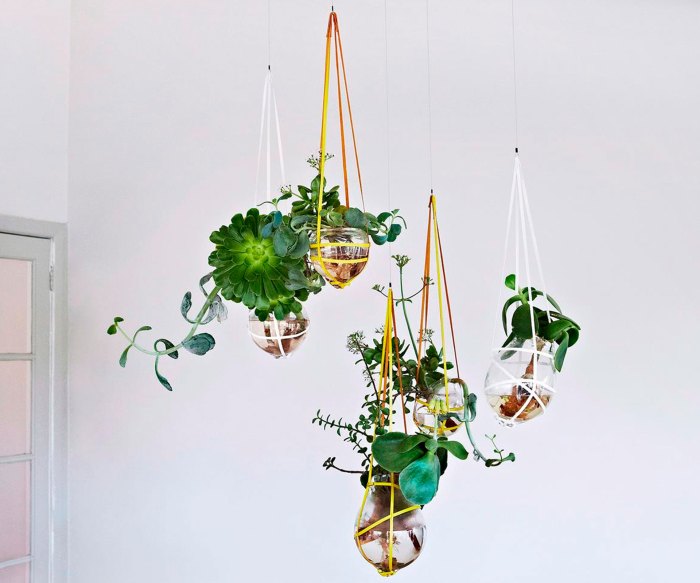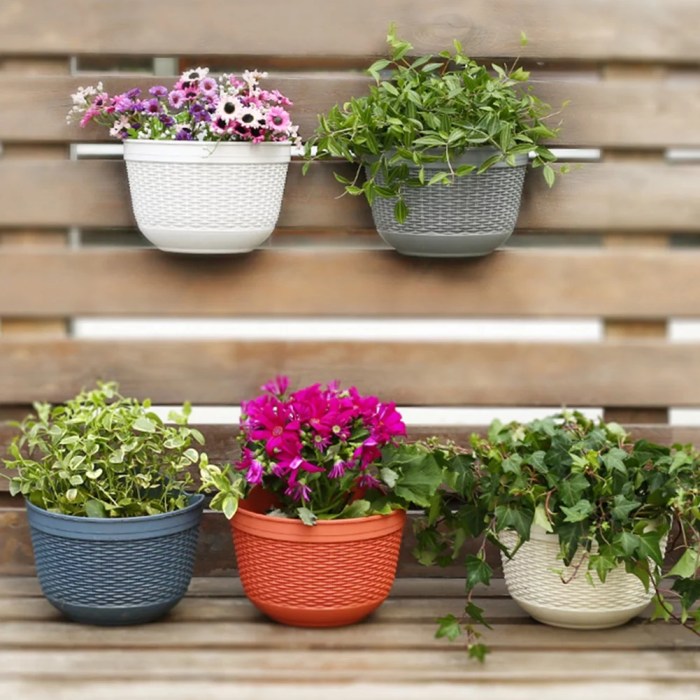Plants that hang from the ceiling are a unique and beautiful way to add life and style to any space. Whether you’re looking to create a lush indoor jungle or simply add a touch of greenery to your home, hanging plants are a great option.
In this guide, we’ll cover everything you need to know about hanging plants, from choosing the right plants to installing and caring for them. We’ll also provide tips on how to use hanging plants to create a beautiful and inviting space.
Hanging Plants
Hanging plants add a touch of greenery and life to any space. They can be used to create a vertical garden, add a splash of color, or simply bring the outdoors in.
There are many different types of hanging plants to choose from, each with its own unique look and benefits. Some popular choices include:
- Spider plants: These plants are known for their long, trailing stems and easy-to-care-for nature.
- Pothos: Pothos plants are another popular choice for hanging baskets. They are known for their heart-shaped leaves and ability to tolerate low light conditions.
- Ferns: Ferns are a great way to add a touch of elegance to any space. They come in a variety of shapes and sizes, so you can find one that’s perfect for your needs.
- Air plants: Air plants are a unique type of plant that doesn’t need soil to grow. They get their nutrients from the air, so they’re perfect for hanging in baskets or terrariums.
Hanging plants offer a number of benefits, including:
- They can help to purify the air.
- They can add a touch of color and life to any space.
- They can help to reduce stress and improve mood.
- They can be a great way to add a touch of nature to your home.
When choosing hanging plants for your space, there are a few things to keep in mind:
- The amount of light available. Some plants need more light than others, so be sure to choose plants that are suited to the amount of light you have available.
- The size of the space. If you have a small space, you’ll want to choose plants that are relatively small. If you have a large space, you can choose larger plants or even create a vertical garden.
- The style of your home. There are many different styles of hanging plants to choose from, so be sure to choose plants that match the style of your home.
With a little care and attention, hanging plants can be a beautiful and beneficial addition to any home.
Types of Hanging Planters

Hanging planters come in various types, each with its unique advantages and drawbacks. The choice of planter depends on factors such as the plant species, the desired aesthetic, and the available space.
Materials Used in Hanging Planters
- Ceramic: Durable, heavy, and available in various colors and designs. However, it can be expensive and prone to breakage.
- Plastic: Lightweight, affordable, and weather-resistant. However, it may not be as aesthetically pleasing as other materials.
- Metal: Sturdy, durable, and available in various finishes. However, it can be prone to rust if not properly coated.
- Wood: Natural, aesthetically pleasing, and durable if treated properly. However, it can be heavy and require regular maintenance.
- Macrame: Decorative, lightweight, and made from natural fibers. However, it may not be suitable for heavy plants and can be prone to fraying.
Choosing the Right Hanging Planter
When selecting a hanging planter, consider the following factors:
- Plant size and weight: Choose a planter that is large enough to accommodate the plant’s root system and support its weight.
- Drainage: Ensure the planter has drainage holes to prevent waterlogging, which can lead to root rot.
- Style: Select a planter that complements the plant’s foliage and the overall decor of the space.
- Hanging mechanism: Consider the type of hanging mechanism (e.g., chain, rope, bracket) and ensure it is strong enough to support the planter and plant.
Installation and Care

Hanging plants add a touch of greenery and style to any space, but it’s important to install and care for them properly to ensure they thrive. Here’s a guide to help you get started.
Installation
To securely install hanging planters, choose the right type of hook or bracket for the weight of the planter and plant. Use screws or bolts to attach the hook to a stud in the ceiling or a solid beam. If there’s no stud or beam, use a heavy-duty adhesive or drywall anchor.
Hang the planter from the hook and adjust the height to your desired level. Make sure the planter is stable and won’t swing or sway excessively.
Watering and Fertilizing, Plants that hang from the ceiling
Hanging plants need regular watering, especially during the summer months. Check the soil moisture regularly by sticking your finger in it. If the soil feels dry to the touch, it’s time to water.
Water the plant thoroughly until water drains out of the drainage holes. Allow the excess water to drain away before hanging the planter back up.
Fertilize hanging plants every few weeks during the growing season with a balanced liquid fertilizer. Follow the instructions on the fertilizer label for the correct dosage.
Pruning and Maintenance
Regular pruning is essential for keeping hanging plants healthy and looking their best. Prune away any dead or damaged leaves or stems, as well as any growth that becomes too long or unruly.
Check the plants regularly for pests or diseases. If you notice any problems, treat them promptly with an appropriate pesticide or fungicide.
End of Discussion: Plants That Hang From The Ceiling

Hanging plants are a versatile and easy way to add beauty and life to any space. With a little care and attention, they can thrive for years to come. So what are you waiting for? Get started today and create your own living oasis!
Answers to Common Questions
What are the benefits of hanging plants?
Hanging plants can help to improve air quality, reduce stress, and boost creativity. They can also add a touch of beauty and style to any space.
What are some of the most popular hanging plants?
Some of the most popular hanging plants include pothos, spider plants, and ferns. These plants are all relatively easy to care for and can tolerate a variety of conditions.
How do I choose the right hanging plant for my space?
When choosing a hanging plant, you’ll need to consider the amount of light, humidity, and space you have available. You’ll also want to choose a plant that complements the style of your home.